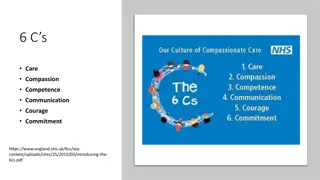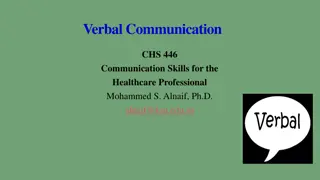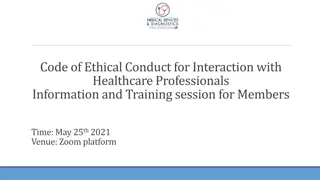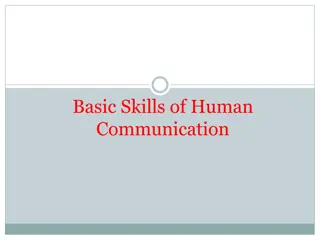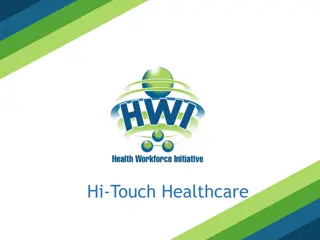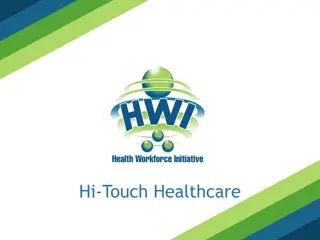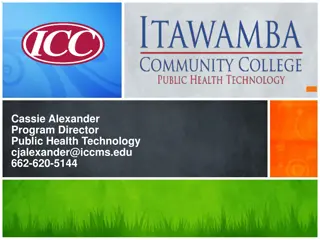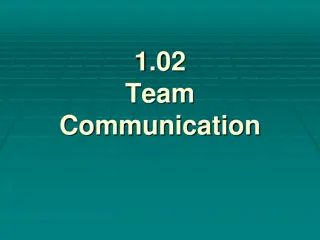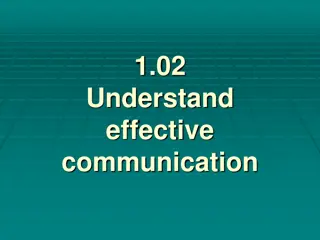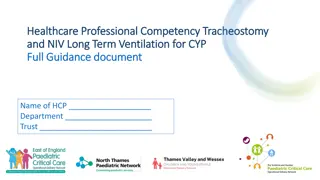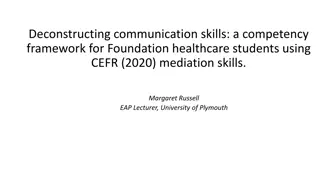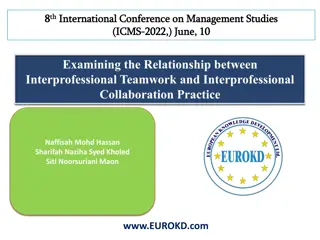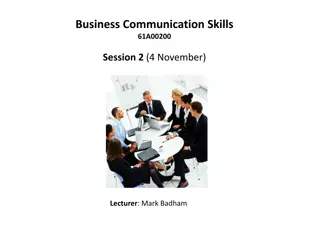Effective Communication Skills for Healthcare Professionals
Enhance your communication skills with the Accelerated Preceptorship Communication Session by Desiree Cox. Learn the importance of effective communication, different communication preferences, communication dynamics, non-verbal communication, listening skills, and more. Understand the communication process based on Shannon and Weaver's model, the impact of communication channels, and the significance of non-verbal cues. Develop listening skills to empathize and understand others better in the workplace.
Download Presentation

Please find below an Image/Link to download the presentation.
The content on the website is provided AS IS for your information and personal use only. It may not be sold, licensed, or shared on other websites without obtaining consent from the author. Download presentation by click this link. If you encounter any issues during the download, it is possible that the publisher has removed the file from their server.
E N D
Presentation Transcript
Accelerated Preceptorship: Communication Session Desiree Cox For Newly Qualified Practitioners and Healthcare Professionals on Temporary Register CapitalNurse is jointly sponsored by Health Education England, NHS England and NHS Improvement
Objectives Understand the importance of effective communication at work Understand how to promote effective communication Understand different communication preferences
Topics Communication dynamics Impact of communication in workplace Non-verbal communication Listening skills Barriers to communication and strategies VAK styles Transactional analysis
Communication Process Based on Shannon and Weaver s communication model (1949), communication is seen as a chain along which a message passes through five stages: The message is sent in whichever format (verbal, electronic, written) They put the message into a code subconsciously Sender has a message to send The message is received and decoded subconsciously The message is understood
Impact of Communication channels Research conducted by Albert Mehrabin showed that the words used are actually the lowest factor in understanding. Body language and tone account for more impact, however are often given less consideration in communication Telephone Face-to-face 20% 7% Words 80% 25% Tone - 68% Body language Albert Mehrabin, 1970s
Non-verbal communication Non-verbal communication involves: Body language Eye contact Voice, tone, expression and quality Gestures Facial expressions Use of touch and the zones around us Head movements Posture
Listening skills Focus on the other person Observe facial expressions and gestures Listen to the tone and emphasis Listen to understand Avoid being distracted Empathise with the other person Reflect back your understanding
L I S T E N look interested information seeking ask questions stick to the subject concerned and focus test your understanding with feedback and summary evaluate the message to check interpretation neutralise your thoughts against previous assumptions
Impact of communication Communication can have both positive and negative results on relationships in the workplace and patient care: Positive Negative Develops trust between staff and patients Promotes a positive working environment Improved team working Encourages staff to share information Encourages transparency and honesty Small things get missed Misunderstandings leading to mistakes Blame culture Staff feel demotivated increased attrition Poor team working with impact on service Patient care suffers
Why is communication important? Studies conducted during the past three decades show that the clinician s ability to explain, listen and empathize can have a profound effect on biological and functional health outcomes as well as patient satisfaction and experience of care Institute of Healthcare Communication
Activity Spend a few moments thinking about the barriers to effective communication both with colleagues and patients / service users For each barrier, identify strategies to overcome these
Barriers to Communication Age generational differences in vocabulary Personal style may be positive or negative Position / status / role Lack of clarity and consistency Lack of credibility Lack of trust or relationship Language, dialect, jargon, abbreviations Culture and religion Timing Method Physical environment
Overcoming barriers Choose most appropriate method for individual and the message itself Consider the environment Clear, concise, simple and direct Avoid information overload Be confident in yourself and quietly assertive Observe and listen Check understanding
VAK Communication Styles Visual Communicators around 65% - prefer face to face contact as they take the message from the eye contact and body language Auditory Communicators around 30% - take the message from the tone, expression and emphasis of the voice. They do not need to see other people, nor to make eye contact Kinaesthetic communicators around 5% - like to be around people, the meaning of communication comes from body language and the sense of the other person
Building Rapport Building rapport with another person can be the difference between success and failure in communication. By building rapport with the other person, they will begin to trust you and communication becomes much easier and more effective. We can begin by smiling, using positive eye contact and tone of voice. Other techniques include: Mirroring and Matching Pacing and Leading
Mirroring and Matching Mirroring and matching are NLP techniques that are used to build rapport sub-consciously. Although a form of mimicry, it should be very subtle and includes matching or mirroring the other person in terms of: Posture how they are sitting / standing, body position (crossed legs or arms) Tone of voice Eye contact Body language When someone is mis-matching the other person will feel uncomfortable and distrustful.
Transactional Analysis Transactional analysis was developed by Eric Berne (1964) as we communicate at both a psychological and social level. It considers three different ego states used in our transactions with others. These are Parent, Adult and Child. In the workplace, transactions should take place between adult ego states and problems occur when different ego states are adopted. Example, a difficult person may assume the ego state of a child to try and get their own way, causing the other person in the transaction to adopt the ego state of a parent, resulting in an ineffective dialogue or a crossed transaction
TA: Ego States Parent Adult Child Free Child Nurturing Parent Adaptive Child Critical Parent Communication & Leadership: Transactional 17
Parent Parent Nurturing Parent Critical/ Controlling Parent Should, Must, Don t, good, Bad, Haven t you?, Why not? Seeks to keep the child contented and clam their fears, can be overprotective, cans top the development of others Words Don t worry, let me help you, it s ok, I ll sort it, Tone (para-verbal) Soothing, consoling, protective Harsh, Abrupt, Authoritative, dismissive, patronising Controlling, Seeks to make the child do want they say, critical, bossy, rule maker Body Language Pat on arm, Nodding encouragingly, Smiling, Proud eyes Finger pointing, arms crossed, rolling eyes, scowling, furrowed brow, Standing over someone Communication & Leadership: Transactional 18
Child Child Free Child Adaptive Child Please, sorry, I can t, I ll try, Yes of course, I won t, may I? Words I wish, wow, love, hate, I want Unencumbered by rules and what you should do, genuine feelings, immature, inconsiderate Tone (para-verbal) Joyful, noisy, energetic, emotionally, crying Complaining, surly, appeasing, nodding, sighing, helpless Compliant (learned to do what they were told to be accepted) or Rebellious (fights back against the system), attention seeking Body Language Exaggerated movements, uninhibited, smiling freely, Head tilt, fidgeting, slouching, downcast, not engaged, Communication & Leadership: Transactional 19
Adult Adult ADULT Decisions and beliefs are scrutinised. Opinions are made up from rationale analysis of all available information. Functions in the here and now. Logical practical thinking Words How, when, I understand, tell me more, what do you think? let s try, lets find, Tone (para-verbal) Calm, clear, even tone, open Body Language Level eye contact, thoughtful facial expression, relaxed, Communication & Leadership: Transactional 20
Types of Transaction Complementary stable ego states, expected responses. Example: Awful weather today. Response: Yes, it is Crossed unexpected responses from different ego states, may be unproductive and transaction is unstable. Example: what time is it? Response: Why do you need to know?
Transactional Analysis P P P P R A A A A S C C C C Complementary Transactions Crossed Transactions
Reflection Reflect on examples you have experienced of crossed and complementary transactions and the resulting impact Consider a recent or past situation that you felt you were lacking in confidence; where you didn t know what to do or felt that you where isolated without support or help. What thoughts where running through your head at the time? Did it trigger an emotional response? What behaviours did you ultimately display? Do you feel fundamentally you re not as good as others?
Acknowledgments Desiree Cox, Preceptorship Project Manager, CapitalNurse Joseph Lynch, Practice Educator, Whittington Health Kristen Leonard, Preceptorship Lead, Imperial College Healthcare
References Berne, E. (1964) Games People Play the Psychology of Human Relationships, London, Penguin Boddy, D. and Buchanan, D. (1992) Take the Lead: Interpersonal Skills for Project Managers, London, Prentice Hall Cox, Desiree (2013). The Hungry Manager, Amazon, UK https://www.managementstudyguide.com/shannon-and- weaver-model-of-communication.htm accessed 31/5/2020 Mehrabian, Albert (1971). Silent Messages (1st ed.). Belmont, CA: Wadsworth. ISBN 0-534-00910-7.
THANK YOU CapitalNurse is jointly sponsored by Health Education England, NHS England and NHS Improvement






